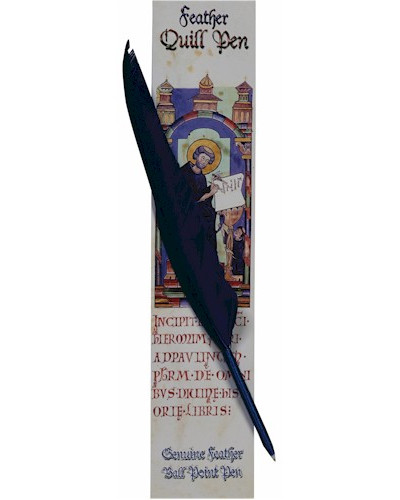Generic Quill Pen
- Product Code: GQUILL
- Availability: In Stock
- Pack Qty: 10
Product Description: This Generic Quill Pen is made from a real feather attached to a ribbon covered pen that has a biro nib. There are 5 different colours available, blue, purple, black, pink and red. The quill pen measures approximately 30-35 centimetres long, however lengths will vary as the feather is a natural product. The quill is supplied with a colourful information card. On the front there is an image of a section of the Worms Bible, depicting St Jerome writing at a desk. On the back is historical information about the development of the pen. The quill and card are held in a clear hanging bag.
Information: Early man used his finger as a pen and plant juice or even blood as ink. Around 4000 B.C. man first scratched the surface of moist clay tablets with a bronze or bone tool. The Romans by 1300 B.C. had developed this form of writing and had started scribing onto thin sheets of wax, which could be melted and re-used.
The earliest ancestor of the pen was the brush made from camel or rat hair used by the Chinese in the first millennium B.C. At about the same time the early Egyptians used thick bamboo reeds with split, carved or frayed ends. They developed the use of papyrus reeds to write on and used hieroglyphics as text.
The writing quill pen came into use in the seventh century. It was the main writing instrument until the introduction of metallic pens and pen nibs that took over in the 1800’s. Some of the best quill pens were made from the flight feathers of geese. The word pen comes from the Latin worn "Penna" which means feather.
During the medieval period monks were given the job of copying text or of taking dictation. When the demand for books became so great, secular scribes were employed to work under the direction of monks.
Writing with quill pens changed little until the middle of the 19th century. By 1850 use of the quill pen had faded and the quality of pen nibs had been improved by tipping them with hard alloys of Iridium.
The front image depicts St. Jerome seated under an architectural arcade. Before him a kneeling monk holds an ink-horn. The saint is writing with a quill, and holding a knife in his left hand.

